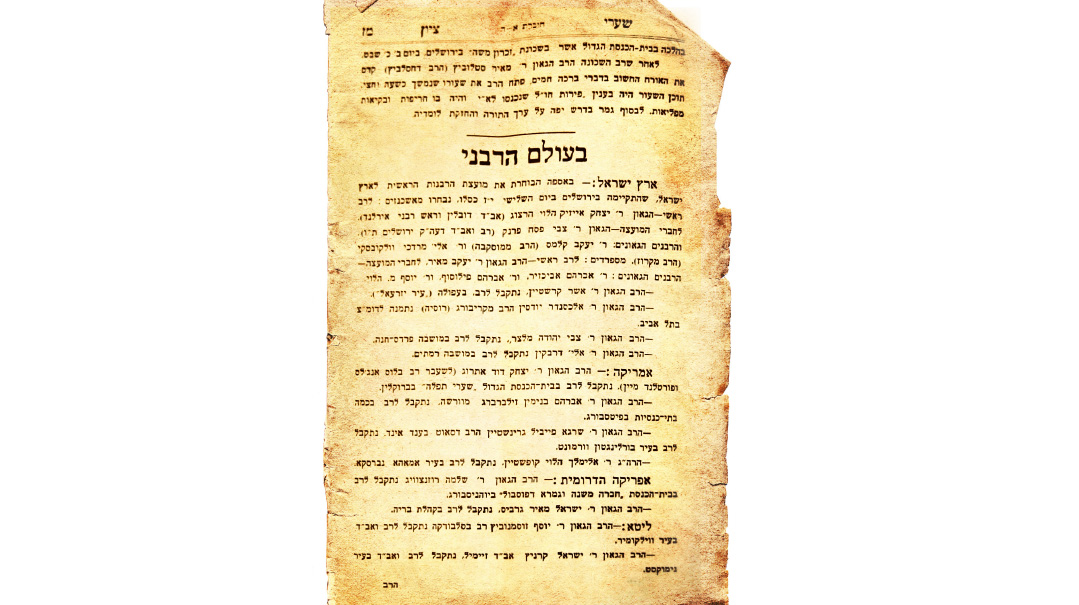The Lithuanian Yerushalmi
| June 28, 2022Rav Yosef Zusmanowitz was born in Yerushalayim in 1894, and henceforth earned the appellation “the Yerushalmi”

Title: The Lithuanian Yerushalmi
Location: Vilkomir, Lithuania
Document: Shaarei Tzion, Volume 17
Time: 1937
A 1937 edition of the journal Shaarei Tzion highlighted some important happenings in the ever-changing rabbinic world. From Palestine there were two major news items: Rav Yitzchok Isaac Herzog was named chief rabbi of the burgeoning yishuv, and Rav Tzvi Pesach Frank was chosen as chief rabbi of Yerushalayim. In America, the well-traveled Rav Yitzchok Dovid Essrig was appointed rabbi of Shaarei Tefillah in Brooklyn, and Rav Avraham Binyomin Zilberberg (great-grandfather of Rav Tzvi Meir Zilberberg) came from Warsaw to Pittsburgh, where he took the reins of several aligned kehillos.
Yet it was a seemingly mundane announcement at the bottom of the page that marked the end of a highly contested race for the rabbinate of Vilkomir, Lithuania, which had sat vacant following the passing of Rav Aryeh Leib Rubin.
Rav Yosef Zusmanowitz was born in Yerushalayim in 1894, and henceforth earned the appellation “the Yerushalmi.” He was the scion of the prestigious De Leon family. His father had come to Israel to represent the keren of the Minsk community. Following his studies in the local Eitz Chaim, he traveled to Lithuania, where he studied in the kibbutz of Rav Itzele Ponevezher. When the yeshivah fled south to Kharkov during World War I, he decided to join the Telz yeshivah. In 1921 he moved on to Slabodka, where he soon became a favorite of the rosh yeshivah Rav Moshe Mordechai Epstein, who soon took him for his daughter Leah as a son-in-law .
With the opening of the Slabodka branch in Chevron in 1924, Rav Epstein’s twin positions as rosh yeshivah and rav of the town of Slabodka were vacated. Rav Yosef Zusmanowitz was already a popular young maggid shiur in the yeshivah, with the talmidim drawn in by his brilliance and charisma. Many saw him as the natural successor to his father-in-law, and Rav Moshe Mordechai himself made a return visit to Slabodka in 1925, ostensibly to secure his son-in-law’s position.
Though ultimately the Alter of Slabodka’s son in law Rav Isaac Sher would retain the sole position as rosh yeshivah, it was thought that the Yerushalmi would inherit the rabbinate of the town.
In this effort he was supported by the townspeople, but the yeshivah community opposed this appointment and lobbied for the appointment of Rav Zalman Osovsky. Following a protracted dispute, the Yerushalmi instead applied for the rabbinate of Vilkomir, vacant since the passing of the beloved Rav Leib Rubin. This position would be accompanied with the responsibility of the local yeshivah, affording him the opportunity of delivering shiurim once again.
As rabbi of the small shtetl of Tzitevian, Rav Yaakov Kamenetsky was struggling to support his family, and securing the rabbinate in the larger town of Vilkomir seemed to be the only way to alleviate the financial burden. Despite his efforts, the Vilkomir community’s candidate of choice was ultimately the Yerushalmi.
Rav Yosef Zusmanowitz was now finally the undisputed rav and rosh yeshivah in a prestigious town, and Rav Zalman Osovsky remained the undisputed rav of Slabodka.
Only in the home of a third Slabodka alumnus — Rav Yaakov Kamenetsky — did a sense of mourning prevail as the family now faced a desperate financial future. Rav Yaakov was left with no choice and he sojourned to the United States. Following some travels and travails, he was hired as rav of a community in Toronto, and he sent for his family in Lithuania.
A short time later, with the Nazi invasion of the Soviet Union on June 22, 1941, Lithuania was overrun and the murderous Einzatzgruppen commenced the mass murder of its storied Jewish communities. Among the early victims were Rav Yosef Zusmanowitz in Vilkomir and Rav Zalman Osovsky in Slabodka and their respective families. Safe on the other side of the world, the Kamenetsky family was able to recognize that their darkest day had been a lifesaver and a harbinger of a brighter future.
Chassid for a Day
Following the passing of Rav Meir Shapiro, the yeshivah’s “shilton ruchni” (spiritual government) was established at a meeting of Rabbi Shlomo Eiger of Lublin and Rabbi Eliyahu Mazor, who was the president of the Warsaw Jewish community and the executive director of Yeshivas Chachmei Lublin, to pick a replacement rosh yeshivah. Among the board’s leading candidates was Rav Zusmanowitz. The committee was so eager for him to please the yeshivah that they went so far as to dress him in chassidic garb for his visit. Just like the other Lithuanian candidates who were presented, the Yerushalmi did not obtain the position.
Laying Down The Law
The Yerushalmi was a brilliant and concise writer who authored several seforim, including Chelko shel Yosef, Zera Chayim, Teruas Melech, and perhaps most famously, Mishpat Yerushas Misrah, a pamphlet covering the laws on sons-in-law inheriting rabbinical appointments, as well as whether a rav may transfer his position to a child during his lifetime.
(Originally featured in Mishpacha, Issue 917)
Oops! We could not locate your form.






